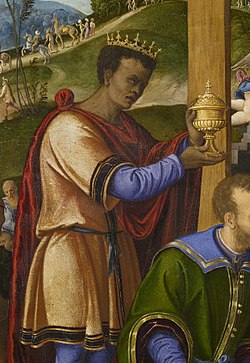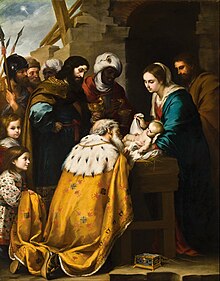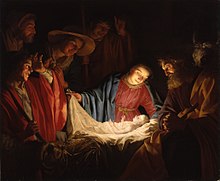Balthazar (magus)
Saint Balthazar | |
|---|---|
 Balthazar in The Adoration of the Three Kings by Girolamo da Santacroce | |
| Three Magi, Three Kings, Three Wise Men | |
| Venerated in | Roman Catholic Church Eastern Orthodox Church Anglican Communion Lutheran Church |
| Canonized | Pre-Congregation |
| Major shrine | Shrine of the Three Kings, Cologne Cathedral |
| Feast | 6 January (Epiphany) 6 January (date of his death) |
| Attributes | King bearing gifts, king on a camel, three crowns |
| Patronage | Epilepsy, thunder, motorists, pilgrims, playing card manufacturers, sawmen, sawyers, travellers, travelling merchants, Cologne, Germany, Saxony |
Saint Balthazar; also called Balthasar, Balthassar, and Bithisarea,[1] was according to Western Christian tradition one of the biblical Magi along with Caspar and Melchior who visited the infant Jesus after he was born. Balthazar is traditionally referred to as the King of Macedonia and gave the gift of myrrh to Jesus. In the Roman Catholic Church, he is regarded as a saint (as are the other two Magi).
Tradition[]
The Gospel of Matthew does not give the names of the Magi (or even how many there were), but their traditional names are ascribed to a Greek manuscript from 500 AD translated into Latin and commonly accepted as the source of the names.[2] In this original manuscript, Balthazar is called Bithisarea, which later developed into Balthazar in Western Christianity.[1] Balthazar was described in the 8th century by Saint Bede as being "[of] black complexion, with [a] heavy beard" with the "myrrh he held in his hands prefigured the death of the Son of man".[3]
As part of the Magi, Balthazar followed the Star of Bethlehem first to the palace of Herod the Great who instructed them to return to him when they had found the Child Jesus. When they arrive at the house,[4] the Magi worshipped him and presented their gifts. Balthazar gave the gift of myrrh, which symbolised the future death of a king, as myrrh was an expensive item at the time.[5][6] Following his return to his own country, avoiding King Herod, it is purported that Balthazar celebrated Christmas with the other members of the Magi in Armenia in 54 AD but later died on 6 January 55 AD, aged 112. The feast day of Balthazar is also 6 January, as the date of his death.
Balthasar and Gaspar are characters in the 1880 novel Ben-Hur: A Tale of the Christ and the various film adaptions of the novel, which chronicles his later years.
Commemoration[]
Balthazar, along with the other Magi, are purported to be buried in the Shrine of the Three Kings in Cologne Cathedral following his remains being moved from Constantinople by Eustorgius I in 344 AD to Milan. In 1164, Holy Roman Emperor Fredrick Barbarossa moved them to Cologne.[7] Balthazar is commemorated on Epiphany with the other members of the Magi but in Catholicism, Balthazar's feast day is on 6 January because it was the day that he died.[8]
Blackface controversy and traditional iconic representation[]
Many traditionally Christian countries stage pageants that include roles for the three wise men. In mainland European countries it is customary for Balthazar, based on Saint Bede's description of him, to be portrayed by a person in blackface. In a tradition dating from the Middle Ages dark skinned people were described as bringers of gold. In the 21st century, a number of campaigns in Spain pushed for a black person to play Balthazar rather than a person in blackface, which potentially goes against the tradition that local city Councillors play the role.[9]

Since King Balthazar, in traditional pictorial representations from the Late Middle Ages, is represented as a black person (as an integrating or cosmopolitan graphic symbol, in the tradition that the "wise men" or "magi" who worshipped Jesus in Bethlehem represented the peoples of the whole world), fitting in with this traditional icon motivated his representation in the cavalcades of Three Wise Men by a person made up in black. In many Spanish towns that custom continues, while others now ask a prominent resident of African descent to take on this role in the cavalcades.[10]
See also[]
References[]
- ^ a b "Excerpta Latina Barbari: 51B". Retrieved 2016-01-01.
- ^ *Metzger, Bruce, New Testament Studies: Philological, Versional, and Patristic, Volume 10, 1980, BRILL, ISBN 9004061630
- ^ "Three Kings Balthazar, Gaspar, Melchior". CNN. 2013-01-06. Retrieved 2016-01-01.
- ^ Matthew 2:11
- ^ Tischler, Nancy (2010). All Things in the Bible: M-Z. Greenwood Publishing Group. p. 476. ISBN 978-0313330841.
- ^ Freeman, Margaret (1978). The story of the Three Kings: Melchior, Balthasar and Jaspar. Metropolitan Museum of Art. p. 67. ISBN 9780870991806.
- ^ David Lowenthal, The Heritage Crusade and the Spoils of History (Cambridge: Cambridge University Press, 1998), xvi.
- ^ "Magi". Catholic Encyclopedia. 1910-10-01. Retrieved 2016-01-01.
- ^ "¡¡Guerra al Baltasar pintado!!" (in Spanish). GuinGuinBali.com. 2012-02-13. Archived from the original on 2016-01-08. Retrieved 2016-01-01.
- ^ "El rey Baltasar de Pamplona seguirá siendo un blanco pintado de negro" (in Spanish). elperiodico.com. 2015-12-30. Retrieved 2018-12-15.
- Biblical Magi
- Christmas characters
- Unnamed people of the Bible
- Saints from the Holy Land
- 1st-century BC Christian saints
- Christian saints from the New Testament
- Black people in European folklore
- Black people in art
